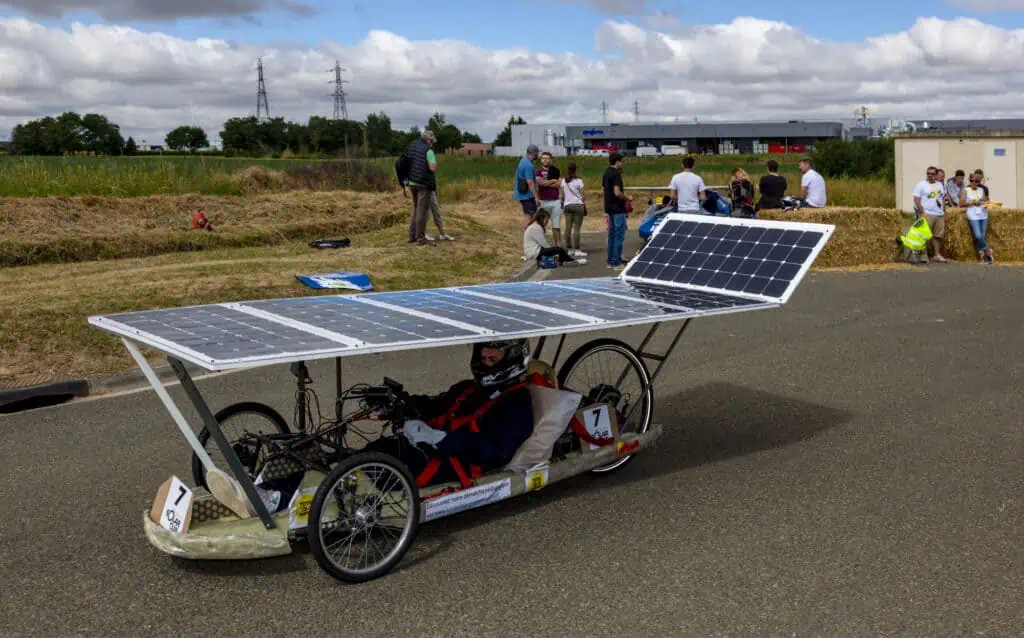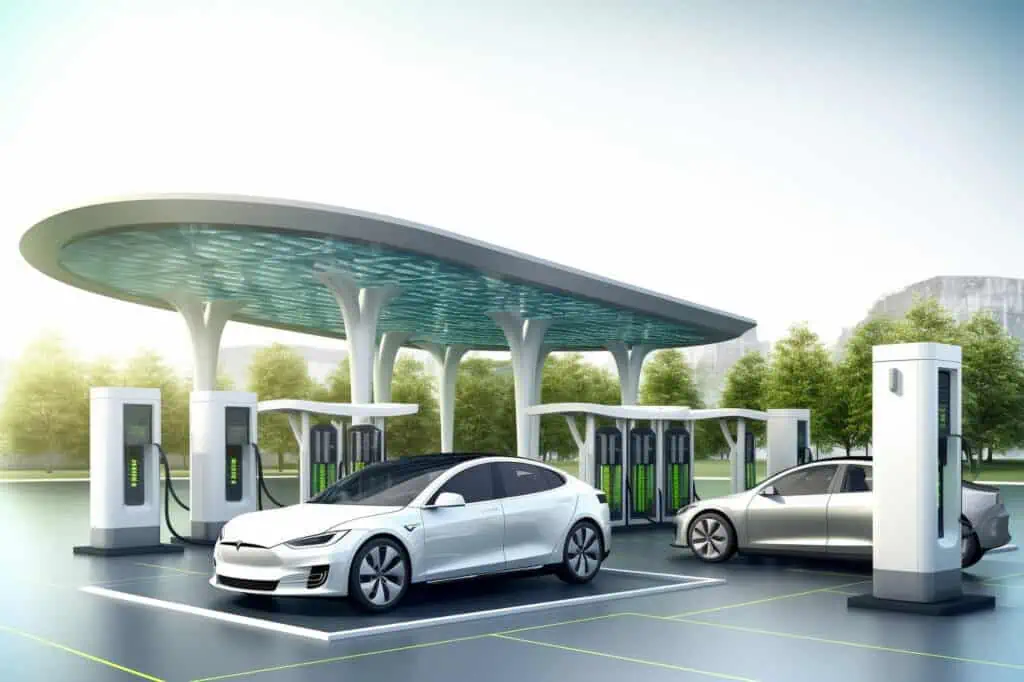In a world trying to untangle itself from the damage done by centuries of fossil fuel use, there is one repeating call to action.
The phrase that has increasingly been heard on the lips of environmentally-conscious people: “Save the Planet!”
Among the promising solutions presented, “solar power” is often the anthem of eco-warriors. This includes policy-makers.
Solar power harnesses the enormous energy of our celestial lifeline—the Sun. A source of energy that’s as abundant as it gets and sustainable for the foreseeable future.
Solar panels are assembled clusters of photovoltaic cells. Solar panels are assembled clusters of photovoltaic cells that transform sunlight into electricity. They can power homes in every corner of our planet that the sun touches.
But the question we’re exploring today takes this concept one step further: What if solar panels could power not only our homes but also our cars?
This article aims to dive into the potential of using solar panels to provide energy for cars.
Contents
The Science Behind Solar Energy
How Solar Panels Work
Understanding solar panels, or photovoltaic (PV) panels, is crucial before we dive into solar-powered cars. PV panels work on a principle known as the photovoltaic effect.
Simplified, PV cells are like tiny power plants with a single, crucial job: to convert solar power into electricity.
Sunlight is composed of minuscule energy packets known as photons. When these strike the solar cells, the energy absorbed knocks the electrons in the cell out of their atomic orbits. This then creates an electrical circuit.
It’s these particles that result in electricity.
The same electricity that powers your coffee maker can keep your fridge cold. And it could also potentially charge your car!
The Efficiency of These Panels
The efficiency of solar panels is a measurement of their ability to convert sunlight into usable electricity. It’s a key characteristic that has seen substantial improvements over the past decades.
But, several factors can affect the efficiency of solar panels. These include the angle and intensity of sunlight, temperature, and other weather conditions.
The latest developments in solar panel technology aim to tackle these variables. It also aims to enhance efficiency, thus truly pushing the limits of the harnessing capabilities of solar energy.
An Overview of Solar-Powered Cars
What Are Solar-Powered Cars?
A solar-powered car, at its core, is an electric vehicle (EV) that uses a solar array to convert solar power into electricity.
Solar arrays are a group of solar cells linked together.
The electricity produced is stored in a battery. Which then powers the electric motors that propel the car forward.
In contrast to traditional cars that rely solely on fossil fuels, solar-powered cars rely on the sun’s energy.
This offers a renewable, zero-emissions alternative.
How Is Solar Energy Used To Power a Car?
Solar-powered cars use solar panels. These are typically installed on the roof to absorb maximum sunlight.
This generated electricity is either used instantly to power the car or stored in the battery for future use. This self-sustaining design theoretically allows the car to run indefinitely.
It’s either that or at least as long as there’s sunlight available—a testament to the powerful utility of solar power.
Examples of Solar-Powered Cars on the Market
While solar-powered cars may still seem like a concept from a futuristic sci-fi novel, they’re becoming more of a reality.
Solar-powered race cars, for instance, have been around for some time, pushing the boundaries of speed and endurance.
In the commercial market, solar vehicles are still relatively developing.
But companies like Lightyear and Aptera are already breaking new ground, as their solar-powered models are drawing international attention.
These companies offer a promising solution to combat climate change. They aim to do this by significantly reducing dependence on fossil fuels. They also aim to provide a sustainable and renewable energy source for transportation.
Lightyear and Aptera capture the interest of environmentally conscious consumers and investors worldwide.
The Feasibility of Solar-Powered Cars
The Energy Needs of a Typical Car
To understand the feasibility of solar-powered cars, we must consider the energy needs of a typical car.
An average car requires about 10-30 kWh of electricity per 100 miles.
A square meter of solar panels, on the other hand, generates about 150-200W per hour in ideal sunlight conditions.
If we crunch the numbers, it becomes clear that a car would need a significant solar array surface to generate enough power.
This is something not currently practical or aesthetically pleasing in most car designs.
Challenges in Using Solar Power for Cars
The potential of solar-powered cars is undoubtedly exciting. But several hurdles must be overcome.
- Geographic Location and Weather: Solar power generation is less efficient in areas with less sunlight or more cloudy days. This means that solar-powered cars might not be as effective in regions with less sunlight or more frequent cloud cover.
- Energy Storage: There is a need to store excess solar energy for use during the night or on cloudy days. Currently, batteries that can store sufficient solar power for these periods are large and costly.
- Size and Efficiency of Solar Panels: To harness enough power, a car must be virtually covered in solar panels. This is a proposition that poses obvious design challenges.
- Initial Cost: The technology for solar-powered cars is still developing. The initial costs of these vehicles can be high compared to traditional cars. This could make them less accessible to average consumers.
- Infrastructure: Currently, there is a lack of infrastructure to support the widespread use of solar cars. This includes charging stations equipped with solar panels.
- Energy Conversion Efficiency: The practicality of solar-powered cars is still limited. This is happening even though the current efficiency of solar panels is improving.
- Durability and Maintenance of Solar Panels: Solar panels on cars need to be durable and able to withstand various environmental conditions. This includes rain, hail, and dirt. All of these can affect their performance over time.
Potential Solutions and Ongoing Research
Despite these challenges, the research and development of solar-powered cars is a buzzing field.
Scientists and engineers worldwide are labouring to increase the efficiency of solar cells. They are also creating better energy storage solutions. They are also working on designing more appealing and practical solar car models.
A promising area of research is hybrid models that combine solar power with other energy sources. This presents a balanced solution that maximizes efficiency and practicality.
The Future of Solar-Powered Cars
Current Advancements in the Field
The field of solar technology is rapidly advancing, with breakthroughs happening at a dizzying pace.
Companies and research institutes are investing in solar cells. They aim to make solar cells more efficient, durable, and affordable.
Some are even developing innovative ways to integrate solar panels into a car’s body. Their main goal is to do so in a sleek and functional manner.
The Impact of Solar-Powered Cars on the Environment
The environmental benefits of solar-powered cars are considerable.
By eliminating the need for fossil fuels, these vehicles represent a cleaner, more sustainable mode of transport.
This shift isn’t just about reducing carbon footprints. It’s also about mitigating noise pollution and improving air quality. The same goes for fostering a healthier environment.
Economic Implications of Solar-Powered Cars
Solar-powered cars could provide significant savings in the long term. This is from an economic perspective.
The initial purchase price might be higher than traditional cars. But, the operating and maintenance costs are usually lower. This is because they require no gasoline and have fewer moving parts.
In many countries, generous tax credits are available for solar power usage. As such, this provides financial incentives for potential buyers.
A Testament to the Transformative Power of Solar Energy
As we wrap up this exploration into solar-powered vehicles, it is clear that these solar-powered cars offer a glimpse into the future.
We’re talking about the future where renewable energy sources like solar power are no longer the exception but the norm in powering our lives.
This innovative concept is creating waves of change in the automotive industry. This innovative concept creates waves of change in the automotive industry. They touch on larger themes of environmental preservation, economic savings and energy independence.
Indeed, solar-powered cars are a testament to the transformative power of solar energy.
While challenges persist, we are confident that these hurdles will be overcome. And they will pave the way for a greener and more sustainable future.
But remember, the advent of solar technology isn’t limited to the automotive world. This powerful, renewable energy source has applications in many areas of our lives. These include everything from powering homes and businesses to fueling entire power grids.
As our reliance on fossil fuels weakens, the importance of understanding and using solar power becomes more crucial.
Take The First Step
In this light, we would like to encourage you to consider going solar. The first step to utilizing the power of the sun is education.
We urge you to add to your knowledge about this vital and burgeoning field of energy production. Solar Comparison is devoted to providing comprehensive and up-to-date resources about solar energy.
We invite you to continue your journey into understanding solar power by exploring our other articles. Each article offers insights into the exciting world of solar energy. They help you understand the benefits and implications of shifting toward this renewable source of power.
Remember, every step taken toward understanding solar power is a step toward a sustainable future.
As the sun continues to rise in the world of renewable energy, we hope you will join us in embracing the vast potential of solar technology.
With your support, solar-driven innovations can play a powerful role in our joint pursuit of an eco-friendly future.
Let’s join hands in this exciting journey towards a brighter, cleaner tomorrow powered by the sun!




